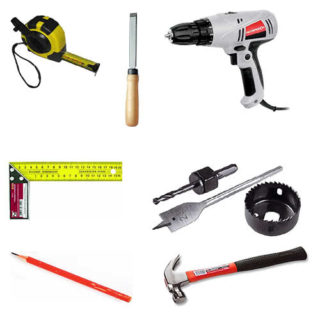The reliability of the door determines the quality of the door leaf, the resistance of the locking device to burglary and professional opening. Installing door locks is considered a difficult task that only specialists can do. By choosing the right lock and following the recommendations, the work can be done on your own.
- Types of door locks
- Main properties influencing the choice of locks
- Classification of locks
- Resilience classes
- Opening methods
- Features of common designs
- Cylindrical
- Suvaldny
- Crossbars
- Installation methods
- The sequence of installing locks in metal doors
- Measurements
- Required tool
- Algorithm for mounting a patch lock
- Insert order
- Professional advice
Types of door locks
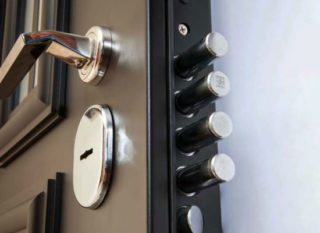
The degree of protection depends on the design, the quality of the materials used in the manufacture.
Main properties influencing the choice of locks
The requirements for locking mechanisms are described by GOST 5089-2011.
The document highlights important consumer properties:
- mechanical resistance to burglary;
- resistance to climatic factors and climatic conditions;
- time of trouble-free operation;
- ergonomics allowing the use of products without restriction, including for people with disabilities and children.
A prerequisite for the certification of high-quality locks is the requirement to use parts in the design that make it difficult to open a criminal.
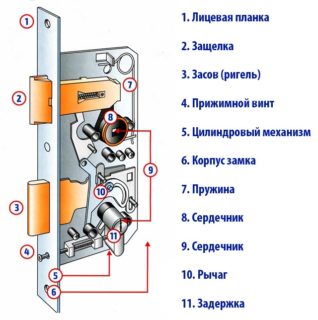
In general, the device consists of the following parts:
- body;
- actuator - bolt or latch;
- a security mechanism that opens the lock with an exceptionally suitable key;
- a drive element giving movement to the bolt;
- "Roll" - a hardened detail that protects against criminal destruction;
- striker plate.
Some types of locking devices may include latches, handles, opening signaling elements, decorative strips.
Classification of locks
GOST 5089-2011 provides features that serve as the basis for classification. Installing a lock on a metal door presupposes the correct choice of a device based on the design, features and properties of the locking devices.
Signs for classification:
- type of secrecy mechanism;
- housing design;
- number of secrecy mechanisms;
- principle of operation;
- right, left, universal, depending on the direction of door opening;
- the number of bolts, which can be from one to four;
- control method - mechanical or electronic key, card, automatic devices.
Additional features are the presence and design of a latch, security mechanism, etc.
Resilience classes
Manufacturers carry out certification upon launch. one of the important factors is resistance to unauthorized access. Based on the characteristics, four classes are distinguished, depending on which the scope of application of the products is determined.
| Protection class | Sustainability | Installation locations |
| 1 | Low | Internal doors in offices and apartments, utility rooms |
| 2 | Normal | Entrance blocks to apartments and offices, industrial premises |
| 3 | Increased | Doors of entrances to apartments, offices and other premises with additional requirements for protection, as well as for locking premises accepted for protection |
| 4 | High | Doors of apartments, offices, office premises, accepted under protection and subject to insurance |
The number of secret combinations of mechanical and electromechanical mechanisms depends on the class of the product and can range from 100 to 10,000.
Opening methods

When choosing a lock, pay attention to the ability of the mechanism to withstand various methods of opening.
Non-destructive techniques involve manipulation and bumping.
In the first case, the secrecy mechanism is opened using a special tool through a key hole or a key selection. An effective protection can be the choice of a lock with a combined method of ensuring secrecy and a large number of combinations.
Bumping - making a master key according to a known pattern of a key, for example, from an impression. The method of protection is to exclude access to the keys by unauthorized persons in public places.
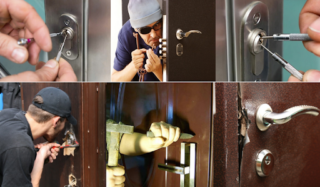
Destructive ways:
- drilling of cylinders and other security mechanisms;
- folding with great effort;
- ripping out or knocking out the secrecy mechanism;
- destruction of leveled locks by "roll-up";
- biting, sawing, folding arches of mounted types or destruction of their bodies.
For protection, manufacturers make some parts and mechanisms that cannot be drilled and rolled. The information must be specified upon purchase.
Features of common designs
To install locks on the entrance doors of apartments, choose products with a cylindrical, lever or disc mechanism.
Cylindrical
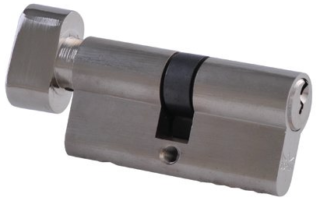
Cylinder locks are of pin, frame and disc design. Depending on the design and the number of secret combinations, the products can belong to any class.
It is not difficult to make keys to mechanisms of 1 and 2 class of protection with your own hands; to counterfeit a key of type 3 of protection, you will need special equipment.
If you lose the key to class 4 locks, you will have to change the larva, which have a very high cost, comparable to half the price of the entire device.
In the expensive segment, products are presented, the secret mechanism of which can be reprogrammed, for which master keys are used. This characteristic will help avoid core replacement.
To protect against destructive burglary, the core and the first pin are made of steel, which cannot be drilled out, and the driving tongue is made of durable metal, which prevents the core from being knocked out.
Among the advantages of cylinder locks, there is the possibility of quick repair and restoration by replacing the secret mechanism (core).
The disadvantage is the cost of devices with a high degree of protection. In addition, the keyhole is not protected from bullies - a match in the keyhole can cause big trouble.
Suvaldny
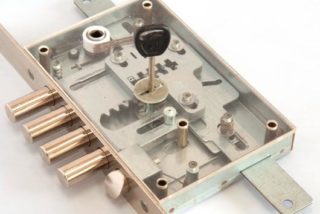
For private premises, they purchase lever locks of 3 and 4 classes of protection. They provide a large number of secret combinations, and the bolts are made of durable steel.
They choose products with at least 6 or 8 levers, this will take a lot of time to select a master key, which in most cases makes the criminal refuse to open the lock.
Among the shortcomings, experts note the large geometric dimensions, which complicate the initial installation.
Crossbars
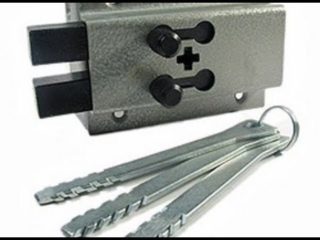
On locks of this type, the bolt (deadbolt) is rigidly connected to the rack and pinion. A key with parallel slots is used to open.
Devices are not self-protection, since they can be easily opened even with improvised means or simple master keys.
The main area of application is installation in a pair with a reliable product of another type of performance.
Installation methods
Depending on the features of the installation, there are padlocks, mortise locks and overhead locks.
The hinged version is most susceptible to hacking with simple devices: a pry bar, a hacksaw, bolt cutters. The weak link of constipation is the bow.The suspension eyes are also prone to damage.
Padlocks are easy to install, but visible, which can be a design flaw.
The disadvantage can be considered a weak resistance to knocking out, which applies to doors that open inside the room.
Installing a mortise lock in a metal door will require the use of a power tool, since it is necessary to make cavities in the canvas and holes in the jamb.
The sequence of installing locks in metal doors
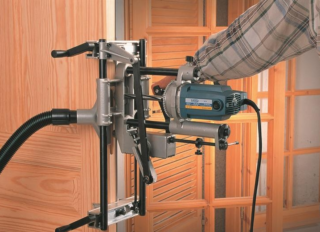
To install or replace a door lock, you will need to follow several sequential steps:
- make measurements;
- purchase a locking device;
- prepare tools;
- carry out the installation.
Each stage should be approached responsibly, as metal processing takes a long time, and errors leave noticeable traces.
Measurements
If the lock needs to be replaced, it is better and easier to find a product with suitable dimensions.
Measure:
- thickness and height of the old locking mechanism:
- the distance between the holes for the mounting bolts;
- the dimensions of the striker and the method of its installation.
Take the old castle with you when you go shopping. It is easy to choose a product with exactly the same characteristics in terms of size.
Replacing the old (patch and mortise) lock with a new one with the same dimensions consists in unscrewing the fastening screws and installing a new device.
In the case of installing a new device, the same measurements are carried out and a suitable device is purchased.
Required tool
- drill or screwdriver with a set of drills for metal;
- Bulgarian;
- ruler pencil;
- screws or self-tapping screws with screw thread;
- center punch;
- screwdrivers;
- file;
- tap for making threads.
To mark the location of the striker, experts advise using chalk or easy-to-wear paints.
Algorithm for mounting a patch lock
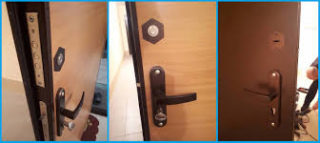
If two types of locks are installed in the doors, overhead models must be installed above the mortise ones - this is more convenient to use the latch.
The algorithm looks like this:
- The lock is applied to the door leaf, the places of the holes for the fasteners and the hole for the secrecy mechanism are marked.
- Drill a hole for mounting the outside of the cylinder or key.
- Holes are drilled in the designated places and the threads are cut for the fastening screws. It is impossible to use self-tapping screws, since they quickly break holes, the reliability of fastening the entire structure decreases.
- Mount the lock case and the secret mechanism cylinder.
- Mark the attachment points of the striker on the jamb. It is convenient to grease the crossbars with paint or chalk and close the lock - marks will remain in the holes.
- Attach the striker.
- Check the performance of the structure. If necessary, widen the opening in the jamb for precise entry of the bolts. Achieve the absence of contact between the crossbars and the strike plate when closing.
- Check the work of the mechanisms.
- Decorative overlays are mounted on the outside of the door and from the end.
In a similar scheme, patch locks are installed on wooden canvases, with the exception that screws are not used as fasteners, but self-tapping screws.
Insert order
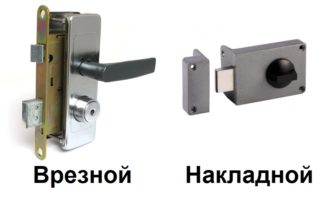
Installation of a mortise lock on the door takes more time; the master will require skills in working with metal.
Sequence of work:
- Mark the place of installation of the mechanism at a height of one and a half from the floor.
- At the end of the sash, mark the place of the groove.
- Holes are drilled in the corners of the marking.
- The grinder cut a groove in the end of the door, focusing on the corner holes.
- Use a file to fit the groove to the exact size of the case.
- Designate a place for a lock cylinder or keyhole for lever locks.
- Holes are drilled in the canvas. Use drills of suitable sizes or tapered tool types.Use a file to adjust the required size.
- Mark the holes for the fastening screws.
- Drill holes and cut threads for screws.
- Places of installation and fastening of the striker are marked, the element is mounted.
- Check the operation of the mechanism, if necessary, adjust the holes for the crossbars in the jamb with a file.
- Carry out the installation of decorative elements.
If everything is done correctly, the door should close / open without undue effort and the rattling of the bolts against the strike plate.
Professional advice
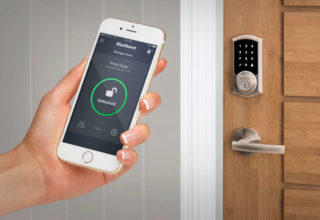
When working, they take into account the peculiarities of installing locks in a steel door and ways to improve the safety of the home.
Professional recommendations:
- it is necessary to use at least two locks of different operating principles;
- before installation, you need to carefully measure the dimensions, use the templates that the manufacturer applies to the passports;
- before drilling holes, make a mark with a core, then the drill will not go to the side;
- when working with a grinder, use personal protective equipment, provide for the possibility of extinguishing a fire from sparks;
- protect the surrounding objects from sparks from the cutting tool;
- drill holes 0.3 mm smaller than the tap size;
- carefully measure the distances after each operation performed;
- make a careful adjustment of the lock and striker so that the actuation occurs smoothly.
Having little skills in working with a power tool and clearly following the instructions, you can install a mortise or patch lock on a steel door yourself. Do-it-yourself work saves money for the wages of the master. A properly installed lock will work for many years, providing reliable protection for your home.

